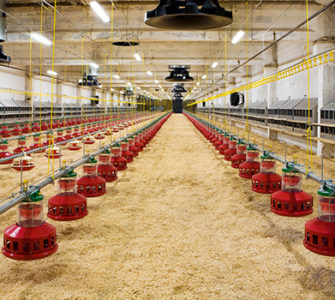Veteran poultry scientist optimistic about managing necrotic enteritis in NAE flocks
The trend toward “no antibiotics ever” (NAE) poultry production has no doubt spawned problems with necrotic enteritis (NE), but the industry is making progress in its search for alternative methods of managing the disease, Charles Hofacre, DVM, PhD, MAM, president of the Southern Poultry Research Group, said in a keynote address at the 2017 International Poultry Scientific Forum.1
Hofacre gave a run-down of the events that are driving the NAE production trend. They include customer and consumer demand for reduced or no use of antimicrobials and the updated veterinary feed directive rule that took effect on January 1, 2017, which prohibits the use of medically important antimicrobials for performance purposes.
Before the NAE production trend, NE was rare in commercial poultry flocks because some in-feed antibiotics helped to prevent the disease. With NAE production, the prevalence of NE in broilers can be as high as 30% to 50% in winter, Hofacre said.
Risks for NE
NE occurs after the intestines are damaged by coccidial cycling, which damages the intestinal mucosa and in turn results in the proliferation of Clostridium perfringens. In flocks vaccinated against coccidiosis, the average age at which NE appears is 16 days, but it can occur as early as 11 days and as late as 28 days of age, Hofacre said.
NE seems to be more of a problem on farms with poor husbandry practices. Clean or new litter is a risk factor for NE development. The disease tends to be more severe in winter and shows up during the second or third growout after NAE production is initiated, he continued.
Proposed solutions
Nevertheless, Hofacre sees progress being made to prevent or control NE, especially if all industry players — veterinarians, nutritionists and producers — continue to work together to find solutions, he said in his presentation titled “An Optimist’s View on How We Will Maintain Broiler Gut Health and Performance in Today’s NAE, Food Safety and FDA Regulatory Climate.”
One of the first steps producers initiating NAE production should take is ensuring their chicks are of good quality. Bird density should be lower compared to conventional production, and there should be downtime of at least 14 days between flocks.
A combination of coccidiosis vaccination to control coccidiosis followed by a non-ionophore anticoccidial to manage coccidial cycling may be required, he said.
Antibiotic alternatives
The use of antibiotic alternatives may help prevent or manage NE. Those include enzymes such as phytase and amylase, prebiotics, probiotics, organic and inorganic acids, essential oils and immune stimulants and modulators. Combinations of products might work best, and producers have to learn what’s effective in their flocks by trial and error and over time, Hofacre said.
Feed ingredients should be selected carefully to ensure quality, and there must be an effective coccidia-control strategy in place to minimize intestinal epithelium damage, promote healthy gut microflora and discourage toxic strains of C. perfringens from multiplying, he advised.
Industry is relearning
In an interview with Poultry Health Today after his presentation, Hofacre explained that over the last 40 years, the US broiler industry worked hard using anticoccidials and antibiotics to maintain the intestinal health of birds. The demand for poultry raised without antibiotics, which includes the ionophore anticoccidials, is forcing the industry to relearn how to grow broilers. It’s a whole new process, but he’s confident that “we’re going to have a very successful broiler industry.”
In the future, the most successful coccidiosis-control tool will depend on vaccination, which will allow the birds’ immunity to control the coccidia. The industry hasn’t yet figured out the best way to apply coccidiosis vaccines, but they’ll be the best solution in the long term. They’ll be the “bread and butter” of coccidiosis control, Hofacre said.
—
1 Hofacre C. An Optimist’s View on How We Will Maintain Broiler Gut Health and Performance in Today’s NAE, Food Safety and FDA Regulatory Climate. 2017 International Poultry Scientific Forum. Atlanta, Georgia.
Posted on July 14, 2017

















